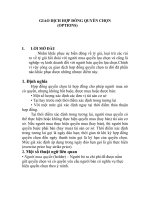slide dịch hợp đồng ftu chương1 negotiating delivery theory
Bạn đang xem bản rút gọn của tài liệu. Xem và tải ngay bản đầy đủ của tài liệu tại đây (808.23 KB, 81 trang )
CONTRACT
Teacher : Lê Hồng Linh ( MA)
Tel: 0903 978 552
Email :
1
CHAPTER 1
NEGOTIATING DELIVERY
1. The five steps in negotiating delivery
The problem
How can the exporter be sure that all the necessary
delivery provisions are in the contract?
The principle
The exporter and the buyer should negotiate delivery
systematically, making all necessary decisions and
discussing how they will solve any problems that
may arise.
2
CHAPTER 1
NEGOTIATING DELIVERY
In more depth
Certain questions arise when negotiating
delivery:
What is the date of delivery?
Where the goods must be sent?
Who pays for transportation?
3
CHAPTER 1
NEGOTIATING DELIVERY
In more depth
Other questions are often overlooked.
Negotiating terms of delivery means working
systematically, making sure that all foreseeable
problems are discussed and that approaches to
solving such problems are agreed.
4
CHAPTER 1
NEGOTIATING DELIVERY
Five negotiating steps:
Step 1: Timing: When must delivery take place?
Discuss a delivery schedule:
The date of dispatch from the factory;
The date of loading onto ship;
The date when goods should arrive;
5
CHAPTER 1
NEGOTIATING DELIVERY
The date of delivery: the key to many contract
events, lying at the heart of sales contract.
Although most negotiators fix this date, they
often forget the “What-if?”
What if the Seller is late in sending the goods?
What if there is delay in loading the goods onto
the ship?
What if the ship arrives late?
What if the delivery is late and there is no
reasonable excuse what then?
6
CHAPTER 1
NEGOTIATING DELIVERY
Delay will cost the Buyer money: can the Buyer
reclaim part of his losses from the Seller? And, if
so, how much?
If the contract provides no answers, then the
answers are found in the applicable law.
Accordingly, good negotiators regulate such
matters in their agreement.
7
CHAPTER 1
NEGOTIATING DELIVERY
Step 2: Location: What is the place of delivery?
The question of where delivery takes place is not
as simple as it seems on the surface.
Fair principle: “the exporter should have no
liability for the good when they are beyond his
control”, “Control and responsibility go together”.
8
CHAPTER 1
NEGOTIATING DELIVERY
One common pattern is for exporter to transport
the goods to the docks in his own country for the
importer to organize transport from there (this is
pattern of FOB delivery). Such an arrangement
is usually cheaper than if the exporter tries to
organize door-to-door transport. ..The parties are
free to arrange anything that suits them.
9
CHAPTER 1
NEGOTIATING DELIVERY
Step 3: Transport
Questions:
How is transportation?
What mode of transport is most appropriate?
10
CHAPTER 1
NEGOTIATING DELIVERY
For the goods to arrive safely, correct packaging
and shipping marks are essential. Such matters
are often made the subject of separate clause in
the export contract because claims arising from
delay of damage can be settled only if it is clear
who is responsible for packing or marking.
11
CHAPTER 1
NEGOTIATING DELIVERY
Transportation poses a different kind of problem:
documentation. Whatever means of transport is
chosen, correct documentation is essential: If
payment is made by letter of credit – as is often
the case – then the bank must refuse to pay if
the shipping documents are in any way incorrect.
12
CHAPTER 1
NEGOTIATING DELIVERY
Transportation poses a different kind of problem:
documentation. Whatever means of transport is
chosen, correct documentation is essential: If
payment is made by letter of credit – as is often
the case – then the bank must refuse to pay if
the shipping documents are in any way incorrect.
13
CHAPTER 1
NEGOTIATING DELIVERY
Step 4: Transfer of risk, transfer of ownership,
insurance
The risk of loss or damage: if the good are
smash by a fork-lift, stolen by stevedore of
damage by a downpour – one side must bear the
loss. Similarly if the goods cause harm to a third
party – for example, a consignment of corrosives
left in the sun explodes and severely burns a
passer-by – who pays? Negotiators often decide,
these risks are transferred at the point of
delivery, and this is standard arrangement under
the Incoterms.
14
CHAPTER 1
NEGOTIATING DELIVERY
Obviously the issue of risk and insurance go
hand in hand. A prudent business man who
faces a risk, arrange insurance.
In international trade, the signature of the
contract and final payment are often widely
separate. And transfer of ownership can take
place at any point between them. The parties
must decide what they want.
15
CHAPTER 1
NEGOTIATING DELIVERY
Step 5: Terms of trade
Example: FOB (free on board), CIF (cost,
insurance and freight)...
16
CHAPTER 1
NEGOTIATING DELIVERY
One term covers a great deal of decision
making.
International trade is agreed, standardized
terminology and provided by the International
Chamber of Commerce in Paris in its set of 13
Incoterms issued most recently in 1993.
17
CHAPTER 1
NEGOTIATING DELIVERY
2. Timing
The problem
The main considerations in drafting provisions
about timing and delay
The principle
Any losses to the buyer caused by nonexcusable delay must be compensated.
18
CHAPTER 1
NEGOTIATING DELIVERY
2. Timing
In more depth
Both seller and buyer should know the exact
delivery date for their own benefit. The delivery
date is extremely important to be a marker to
consider payment time, risk and title passing,
delay compensating, etc.
19
CHAPTER 1
NEGOTIATING DELIVERY
2. Timing
a. Naming the date
The simplest way to name the delivery date is to
use a clear calendar date. But in complicated
cases, common precondition of timing are
usually:
Receipt of import and/or export approval
Receipt of foreign exchange approval from the
central bank
20
CHAPTER 1
NEGOTIATING DELIVERY
2. Timing
a. Naming the date
Insurance of a letter of credit or bank guarantee
Making a down-payment be the buyer
Insurance of insurance-policy
Insurance of a certificate of origin
Delivery of the buyer of plans, drawing or other
documentation.
21
CHAPTER 1
NEGOTIATING DELIVERY
Page 27: Coming into force
This agreement shall come into force after
execution by both parties on the date of the last
necessary approval by the competent authorities
in the country of the seller and the buyer.
If the contract has not come into force within
ninety days of execution, it shall null and void.
22
CHAPTER 1
NEGOTIATING DELIVERY
Page 27:
The date of delivery shall be twenty - eight days
after the date of coming into force of the
contract.
23
CHAPTER 1
NEGOTIATING DELIVERY
2. Timing
b. Timing and “Time is of the Essence”
clauses
Most legal systems do not assume that time is of
the essence of the contract because late delivery
hardly enriches the buyer
24
CHAPTER 1
NEGOTIATING DELIVERY
2. Timing
b. Timing and “Time is of the Essence”
clauses
Most legal systems do not assume that time is of
the essence of the contract because late delivery
hardly enriches the buyer
25









